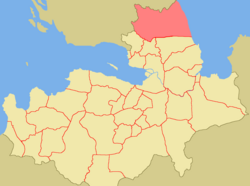North Ingria
Republic of Kirjasalo | |||||||||
|---|---|---|---|---|---|---|---|---|---|
| 1919–1920 | |||||||||
| Anthem:Nouse, Inkeri | |||||||||
 | |||||||||
| Capital | Kirjasalo | ||||||||
| Official languages | Finnish | ||||||||
| Recognised regional languages | Russian | ||||||||
| Government | Republic | ||||||||
| History | |||||||||
• Established | 9 July 1919 | ||||||||
• Disestablished | 5 December 1920 | ||||||||
| Area | |||||||||
• Total | 30 km2(12 sq mi) | ||||||||
| Population | |||||||||
• Estimate | 400 | ||||||||
| Currency | Finnish Mark | ||||||||
| |||||||||
TheRepublic of Kirjasalo(Finnish:Kirjasalon tasavalta), commonly known as theRepublic of North Ingria(Finnish:Pohjois-Inkerin tasavalta) was a short-lived unrecognized state from 9 July 1919 to 5/6 December 1920.[note 1]Kirjasalo was located in the southern part of theKarelian Isthmus,specifically inKirjasaloinLempaala.
Government and the Republic
[edit]Kirjasalo was in control ofapprox.30 square kilometres (12 sq mi), controlling fivevillages,[1]having around 400 total population.[note 2][2]Kirjasalo had its own localProtection Corpsand local newspaperKirjasalo Sanomat.Kirjasalo had its own military regiment, theNorth Ingria Regiment,which was composed of 580–1,700 military volunteers, and led byGeorg Elfvengren,prior to being sacked and being replaced byElja Rihtniemi.[1]The official flag and coat of arms of the Republic of Kirjasalo were designed byIlmari Haapakoskiand were inaugurated on 8 September 1919.[3]Kirjasalo had its own badge of honor, theCross of the Ingrian White Wall.[3]
Government
[edit]Kirjasalo had two types of government in charge of the republic, thePohjois-Inkerin Hoitokunta('North Ingrian Caretaker Committee'), which was theexecutiverefugee governmentestablished in July 1919 by IngrianrefugeesfromBolshevik Russia.The Caretaker Committee was incharge of boosting morale, publishingstampsto raise money, and organizing volunteer regiments, such as theNorth Ingria Regiment.Kirjasalo also had a local council located in Kirjasalo, Lempaala, however it was only ever operational for a couple of months.[1]
| Start day | Start month | Start year | End day | End month | End year | Chair |
|---|---|---|---|---|---|---|
| 9 | July | 1919 | ? | September | 1919 | Santeri Termonen |
| 14 | September | November | Juho Pekka Kokko | |||
| 16 | November | May | 1920 | Georg Elfvengren | ||
| ? | June | 1920 | 5 | December | Jukka Tirranen |
History
[edit]Following theOctober Revolution,andBolshevik Russianexpulsions andmass-mobilizationsofIngrian Finnsin Kirjasalo and other locations, and with theHeimosodat(Aunus Expedition), tensions were high in Northern Ingria. On 9 July 1919, thePohjois Inkeri Hoitokunta('North Ingrian Caretaker Committee') was elected as theexecutive governmentwith Santeri Termonen at its head, and the independence of Kirjasalo was declared in a meeting attended by around four-hundred people inRautu.[4][5]

Finlandbegan to supply Kirjasalo with military equipment, and volunteer activists began to train the Ingrian military volunteers.Georg Elfvengrenbecame the leader of the newly organizedNorth Ingria Regiment,leading around 580 men. On 26 July 1919, Elfvengren launched military offensives towards Ylä-Miikkulainen andLempaalafrom the Finnish border, capturing multiple villages and locations, eventually reaching Perämäki and Putkelovo on 30 July, killing twenty-five Bolshevik troops in the process.[5]Independent separate forces loyal to Kirjasalo occupiedMiikkulainen,a settlement in the far north-east of Ingria, however were later defeated by the Bolsheviks.[6]Due to Bolshevik replenishments, Elfvengren's were forced into retreat, retreating until the village of Kirjasalo.
Elfvengren's hopes of causing a diplomatic incident and causing a wider rebellion amongst Finns and Ingrian Finns in the area had failed terribly.[6]Having performed an attack without the prior approval of the Finnish Government, Elfvengren was sacked and replaced byElja Rihtniemi.[1]Elja Rihtniemi began to construct fortifications in Lempaala and requested weapons from Finland, Rihtniemi would resign two months later, and Elfvengren would be re-hired. Elfvengren began to get back on the offensive in accordance withNikolai Yudenichof theWhite Army,this deal with the White Movement helped Kirjasalo receive four observing officers from theNorthwestern Army,and receive much-needed financial assistance leading to the building of ahospitaland other key infrastructure.[6]Yudenich had signed a deal with Elfvengren for the purpose of getting him to join a planned attack on St. Petersburg.[1]
A new offensive in accordance with Yudenich was started on 21/22 October, with the goal of capturing the village ofToksova,which was the most populous and important centre of North Ingria. The first battle was withRed Finnsat the Gruzino railway station which was used to transport Bolshevik forces. However anarmored trainand workers from the Shlisselburg powder factory, led by I.P. Zhuk arrived to the battle. The Ingrian forces were victorious however were unable to continue their advancements.[6]
Ingrian forces were unable to continue fighting theRed Army,as they were equipped with artillery and armored trains, which the Ingrians did not have, as the Finns once again refused to supply the Ingrian forces except for the donation of topographic maps of the region.[7]The Ingrians lost control over the Gruzino railway station, and were forced to retreat back to Kirjasalo.[6][5]

After theTreaty of Tartu,the entirety ofIngriawas affirmed to be in the control ofBolshevik Russia,a mourning party was hosted on 5 December 1920, during the farewell partyErik Heinrichsheld a speech, after whichNouse, Inkeri,the anthem of Kirjasalo, andPorilaisten Marssiwere sung.[1]The State Flag was saluted and lowered on 6 December 1920, and on the same day the village of Kirjasalo left forFinland.[1]
See also
[edit]References
[edit]- ^abcdefgNiinistö, Jussi (2016).Heimosotien historia 1918-1922(in Finnish). Suomalaisen Kirjallisuuden Seura.ISBN978-952-222-846-8.
- ^"Inkeri".www.conflicts.rem33.com.Retrieved2019-09-20.
- ^ab"Inkerin tunnukset".Web Archive: Suomen Inkeri-liitto. Archived fromthe originalon 25 March 2016.Retrieved10 March2023.
- ^"Пюккенен А. Ю.,Сыров А. А. (Тиайнен А.)Ингрия в огне. Малоизвестный эпизод Белого движения ".Archived fromthe originalon 2016-08-16.Retrieved2013-01-14.
- ^abcMusaev, Vadim Ibragimovič (2004).Političeskaja istorija Ingermanlandii v konce XIX - XX veka(Izd. 2-oe, ispr. i dopol ed.). Sankt-Peterburg: Izdat. Nestor-Istorija.ISBN978-5-98187-031-6.
- ^abcdeTargiajnen, Michail A. (2001).Ingermanlandskij izlom: borʹba ingermanlandskich finnov v graždanskoj vojne na Severo-Zapade Rossii (1918 - 1920 gg.).S.-Peterburg: Bulanin.ISBN978-5-86007-269-5.
- ^"The Ingrian Question As a Historical and Political Phenomenon"(PDF).webcitation.org.Retrieved2024-06-21.
Notes
[edit]- ^MostFinnish-languagesources state 5 December 1920 as the date when the republic was dissolved, howeverRussian-languagesources state 6 December 1920 as the date when the republic was dissolved.
- ^IncludesMilitary volunteers,Civil Guardsmen,and Finns and Ingrian Finns that moved to the controlled villages temporarily.
External links
[edit]- Ingria on Fire: A little-known episode of the White Movement(in Russian),including a map of Finnishtoponyms.


